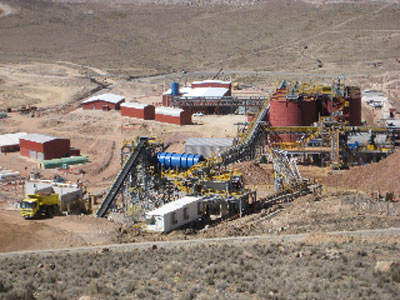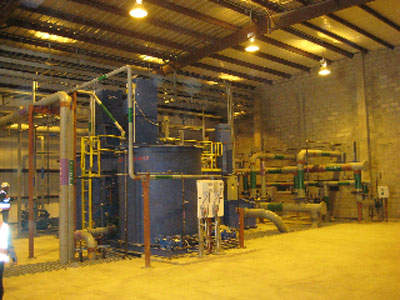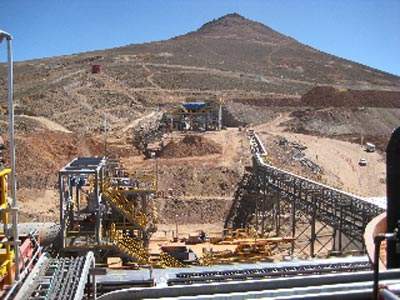The San Bartolomé silver mine project is located just south of the city of Potosi, southern Bolivia, in the Cordillera Central, east of the Andean divide, and sits from 3,900m to 4,700m above sea level. It is owned and operated by Empresa Minera Manquiri SA, a wholly owned subsidiary of Coeur d’Alene Mines Corporation of the US. The Bolivian national mining company, Corporación Minera de Bolivia, is the underlying owner of all the mining rights relating to the project.
Coeur began introducing ore to the mill in April 2008, and when full plant capacity is reached – forecast for August 2008 – San Bartolomé will be the world’s largest pure silver mine, producing about 9 million ounces a year.
Construction of the open-pit milling operation and processing facility has cost about $174m. After production starts, an estimated $18m in sustaining capital will be needed during the mine’s expected 15-year life. Life-of-mine cash operating cost will be $7.31/oz Ag recovered in doré.
GEOLOGY
The project will exploit mineralogical resources from four deposits – Huacajchi, Santa Rita, Diablo Este and Diablo Norte – on the flanks of Cerro Rico Mountain and the surrounding areas near Potosi.
Basement rocks at Cerro Rico are predominantly Ordovician to Silurian continental clastic and shallow marine sedimentary rocks, and locally Cretaceous continental clastic rocks. Regionally, basement rocks are overlain to the west by intermediate volcanic rocks of the Oligocene Agua Dulce formation and to the east by a sequence of rhyolite ash-flow tuffs related to the early Miocene Kari Kari caldera. Directly beneath Cerro Rico, basement rocks are overlain by a thick sequence of middle Miocene volcanic and volcaniclastic rocks termed the Caracoles formation.
MINERALISATION
Disseminated silver and tin mineralisation in silicified rhyodacite alteration is the most important ore-source rock in the project’s deposits. Veins are hosted primarily in the rhyodacite intrusion, but at depth, where the intrusion narrows, they extend into the wall rocks. Both wall-rock alteration and vein mineralisation show pronounced vertical and horizontal zoning. Alteration grades upward from a high-temperature core of quartz-tourmaline at depth through quartz-sericite pyrite and quartz-dickite into pervasive silicification.
The project will also exploit oxide mine dumps left over from historic mining activities on Cerro Rico.
Indicated resources at San Bartolomé are estimated at just over 14Mt at a grade of 76.1g/t, with inferred resources of 225,600t at 61g/t, giving a total contained silver figure of just less than 35Moz. Probable reserves are estimated at just over 38Mt, at a grade of 124.8g/t, giving about 153Moz contained silver ounces.
PRODUCTION
Mining will be straightforward due to the geological nature of the materials. The general concept is to use dozers to push ore to loaders for transfer to haul trucks. The primary mining equipment fleet consists of track dozers, front-end loaders, rear-dump haulage trucks and excavators.
PROCESSING
Plant throughput is designed for up to 5,600t/day and it is expected to recover 96.1 million ounces of silver in doré over the project’s life. The overall silver recovery is projected to be 77.5%.
Three broad ore classifications have been defined for process design – screened, run-of-mine ore from the lower portions of Huacajchi, Santa Rita, Diablo Este, and Diablo Norte; whole ore from the upper portions of the Huacajchi, Santa Rita and Diablo Este deposits; and the oxide waste dumps.
The main process facilities are relatively conventional, consisting of grinding followed by agitation leaching, counter-current decantation (CCD), and final metal recovery in a Merrill-Crowe zinc precipitation circuit.
Screened RoM ore will be passed through a grizzly with the oversize sent to a jaw crusher. The undersized will be slurried in a rotary scrubber and then wet-screened before being fed to the SAG/ball mill circuit.
Whole ore will be fed directly to the jaw crusher then fed to the SAG/ball mill circuit. The oxide-dump ore will be handled in a similar manner.
The grinding circuit discharge will be fed to an agitated-tank leach circuit with an average leach residence time of 60 hours. Leach-tank discharge will be fed to a CCD circuit consisting of three high-rate thickeners, and the extracted pregnant solutions will then be fed to a silver recovery plant where silver will be extracted in a conventional Merrill-Crowe zinc precipitation plant followed by conventional refining to produce doré.
Power requirements for the project will be met by purchasing power from the local power utility, SEPSA. Water will be extracted from sources belonging to the Potosi water authority (AAPOS). Moreover, all available water will be recycled during operations.
The main engineering contractor for the project is Fluor Corporation, headquartered in Texas.






